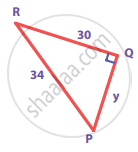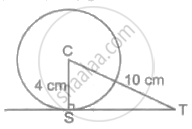Advertisements
Advertisements
प्रश्न
Prove that the sum of the squares of the sides of a rhombus is equal to the sum of the squares of its diagonals
उत्तर

In ΔAOB, ΔBOC, ΔCOD, ΔAOD,
Applying Pythagoras theorem, we obtain
AB2 = AO2 + OB2 ....(1)
BC2 = BO2 + OC2 ....(2)
CD2 = CO2 + OD2 ....(3)
AD2 = AO2 + OD2 ....(4)
Adding all these equation we obtain
AB2 + BC2 + CD2 + AD2 = 2(AO2 + OB2 + OC2 + OD2)
`= 2(((AC)/2)^2 + ((BD)/2)^2 + ((AC)/2)^2 + ((BC)/2)^2)`
(Diagonals bisect each other)
`= 2((AC)^2/2 + (BD)^2/2)`
`= (AC)^2 + (BD)^2`
संबंधित प्रश्न
In triangle ABC, ∠C=90°. Let BC= a, CA= b, AB= c and let 'p' be the length of the perpendicular from 'C' on AB, prove that:
1. cp = ab
2. `1/p^2=1/a^2+1/b^2`
ABCD is a rectangle whose three vertices are B (4, 0), C(4, 3) and D(0,3). The length of one of its diagonals is
(A) 5
(B) 4
(C) 3
(D) 25
ABC is an isosceles triangle with AC = BC. If AB2 = 2AC2, prove that ABC is a right triangle.
Two poles of heights 6 m and 11 m stand vertically on a plane ground. If the distance between their feet is 12 m;
find the distance between their tips.
Find the length of the perpendicular of a triangle whose base is 5cm and the hypotenuse is 13cm. Also, find its area.
In a triangle ABC right angled at C, P and Q are points of sides CA and CB respectively, which divide these sides the ratio 2 : 1.
Prove that: 9AQ2 = 9AC2 + 4BC2
Find the unknown side in the following triangles
Choose the correct alternative:
If length of sides of a triangle are a, b, c and a2 + b2 = c2, then which type of triangle it is?
In ∆PQR, PD ⊥ QR such that D lies on QR. If PQ = a, PR = b, QD = c and DR = d, prove that (a + b)(a – b) = (c + d)(c – d).
In the adjoining figure, a tangent is drawn to a circle of radius 4 cm and centre C, at the point S. Find the length of the tangent ST, if CT = 10 cm.

